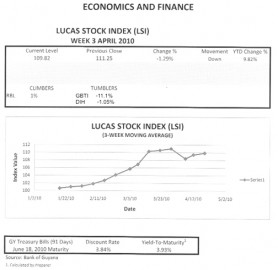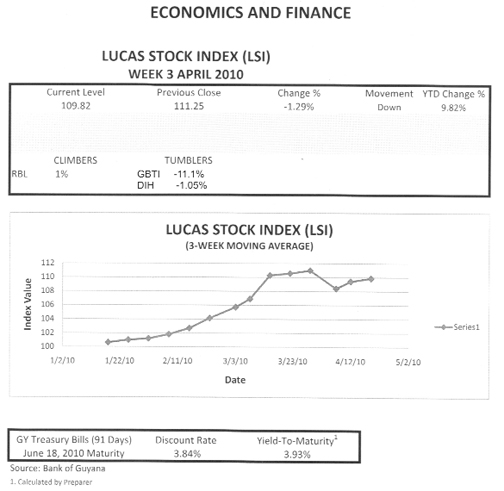Renewable energy
It is a hope that animates many a scientist, consumer and politician. Renewable energy delivers the convenience of a modern lifestyle without polluting the environment. Driving would not contribute to things like smoggy skies or global warming. It would also be fantastic to be able to build a power plant knowing that it wouldn’t sully the land it is built on. Equally gratifying is to have the ability to meet energy needs to protect wild species, whether endangered or secure. Anyone, no matter their feelings about environmental issues, would jump at the chance to take advantage of reliable alternatives to the “fossil fuels” of coal and oil, turning them into true fossils, mere relics of the less advanced, less enlightened past. For a country like Guyana, renewable energy is more than an environmental option. It is a critical economic choice that influences quality-of-life issues.
Renewable Options
However, with current technological capabilities, renewable energy as the sole power source is nothing more than idealism at this point in time. No nation — not even the United States — can hope to foster its development, certainly in the short-run, in this manner. Many options for low-carbon energy exist. In addition to nuclear energy, there are options such as geothermal energy, biomass, and the more popular alternatives in the form of solar, wind, and hydroelectric. Getting to the point of inflection where renewable energy supersedes fossils is far more complicated than meets the eye. Where nuclear energy is concerned, there are issues of waste disposal and global security; following the recent summit in Washington, this option is being denounced or abandoned by several countries. Geothermal energy requires an intense source of heat in the ground similar to what could be found in a volcano — indeed, the best geothermal sources are also volcanic. Biomass and its various combinations do not independently produce as much energy as other sources do and appears best suited to small scale operations.
 Where Guyana is concerned, the choices for beefing up the national grid seem to favour solar, wind and hydroelectric. These choices are not new and have often been talked about as part of Guyana’s long-term economic and environmental protection strategy. Though the cost savings over the long-run are well understood, very little progress has been achieved. The technology exists, but putting these energy sources in place keeps eluding Guyana. The reasons for this failure are unclear, but making any of these options a reality could be circumscribed as much by economics as by technology.
Where Guyana is concerned, the choices for beefing up the national grid seem to favour solar, wind and hydroelectric. These choices are not new and have often been talked about as part of Guyana’s long-term economic and environmental protection strategy. Though the cost savings over the long-run are well understood, very little progress has been achieved. The technology exists, but putting these energy sources in place keeps eluding Guyana. The reasons for this failure are unclear, but making any of these options a reality could be circumscribed as much by economics as by technology.
Solar
Discussing the three options of solar, wind, and hydroelectric might offer some explanation of the challenges facing Guyana. At first glance, solar seems like a good candidate: Guyana is on the equator, so it receives a lot of sunlight. It lacks the drastic temperature changes of temperate climates, so this sunlight will not vary too strongly in intensity, though it will have to contend with the wet season. Guyana’s population is small — not even one million — and the fertility rate is slowly but steadily falling, meaning that electrical consumption will be relatively low. Additionally, powering houses in Guyana is easy; a few solar panels would suffice for an average-sized home.
However, none of this takes into account what would be required to get enough power out of solar cells to perform any serious development. The aim of development is not to merely power homes; it is to provide the base power for an industrialized, modern society, and solar is not yet ready to deliver in a cost effective manner on this front. The nuclear fusion reaction that produces the energy in the first place happens about 93 million miles away; by the time it reaches Earth, it becomes substantially weakened. Thus, the only way to gather an appreciable amount of energy from such a diffuse source would be to snag more of it — and that means larger solar arrays that would take up significant amounts of land and money. In financially rich USA, solar accounts for less than 0.01% of total energy consumption, cost being the primary reason. It is possible to rebut this by citing Guyana’s small population size; however, not only is Guyana’s population still expected to grow, but energy usage by the country would grow as well as it becomes more technological and more modern and tries to provide for the growing demand.
Alternatives to Solar
Wind power suffers from similar problems, but worse, even though it is the fastest growing source of alternative energy. The attractiveness of wind power is that it incurs no water use, no fuel costs and produces no emissions. Wind doesn’t blow at a constant speed, and it doesn’t blow all of the time. Wind energy can be understood in terms of force and velocity which play a big part in providing that energy. It is not possible to increase the wind’s velocity at will, making it necessary to increase the mass by grabbing more wind. That requires building windmills. Air particles are not very massive, and even very large wind farms, such as the one in the Irish Sea, only generate 520 megawatts when the wind is blowing. Surplus wind power cannot be stored, and to make matters worse, transporting the necessary materials to build and maintain the windmills would require large amounts of oil — a fossil fuel. Fitting it into the national grid is a problem, thus wind alone cannot power Guyana’s development either.
The most realistic solution would be to build a hydroelectric dam on one of the active waterfalls amidst the complex of many rivers that underpins Guyana’s name. Several sites for such a project are under consideration in various parts of Guyana’s forested regions. Like wind, hydroelectricity generates energy from mass and velocity, and several of the waterfalls in Guyana have a lot of both. Hydroelectricity is a very popular form of alternative energy and projects in developing countries like Guyana receive substantial support from multilateral financial institutions. However, hydroelectricity comes at a cost. It would not only destroy the scenic view that provides enjoyment to tourists, it would also alter the flow of the river by backing up a lot of water, flooding out the surrounding forest and displacing people and wildlife.
Trade-off
This most favourable choice encounters an internal conflict: Guyana advocates a low-carbon development strategy that is intended to save the forests and prevent carbon emissions. Yet, installing a hydroelectric facility would destroy the surrounding forest, exchanging one environmental problem for another. Unwittingly, the preferred form of development seems to be turning on itself. The question that faces Guyana is whether it wants to sacrifice some of its forest or emit more carbon by building standard power plans.
In today’s energy and environmentally conscious world, the decision is not easy. If Guyana is to develop into something more than what it is, it will need to make the trade-offs and hard choices necessary to do so.









